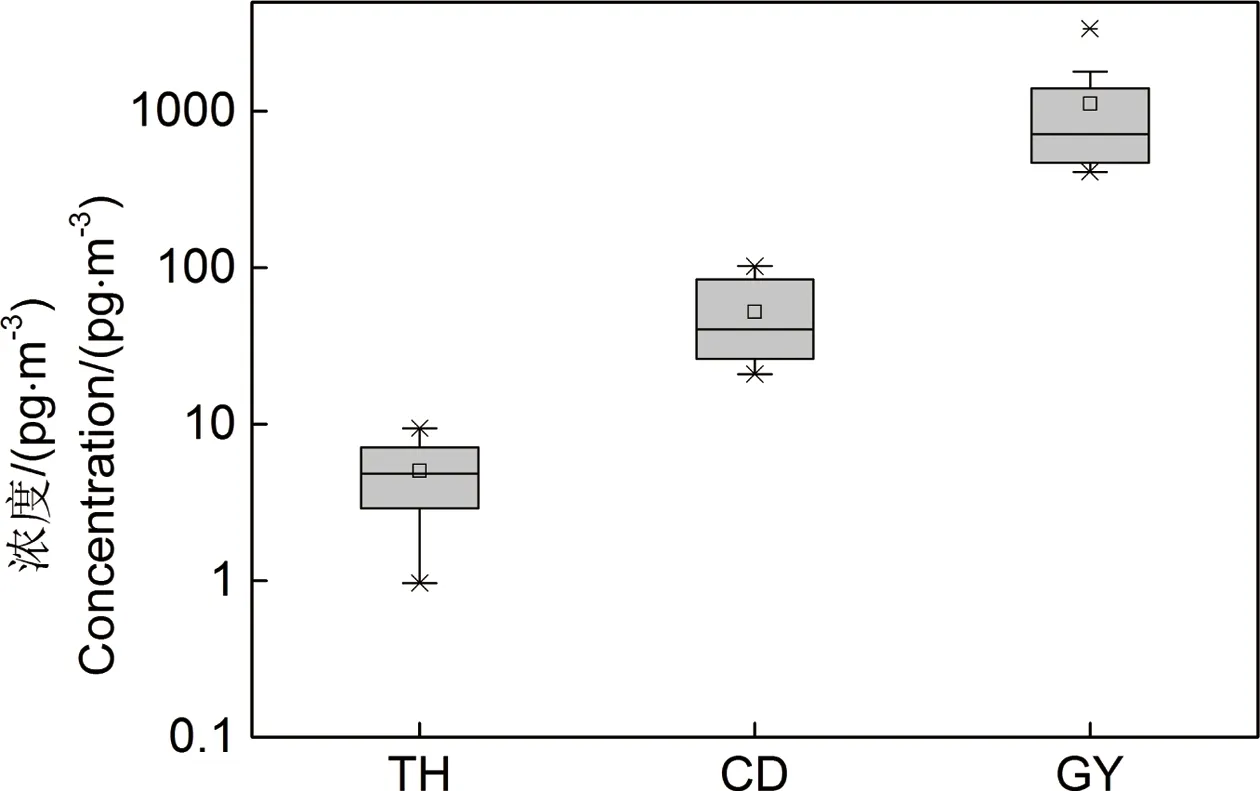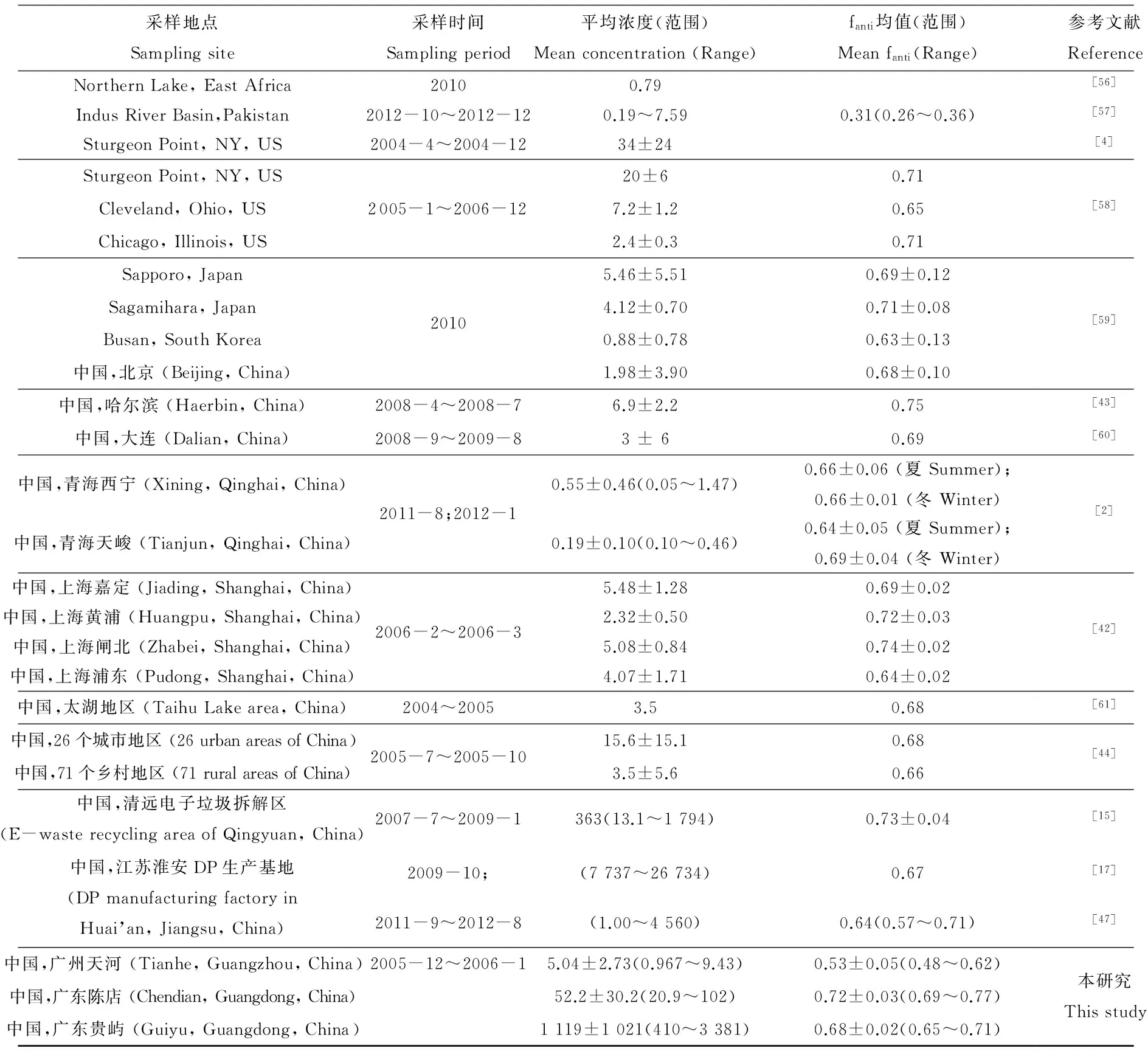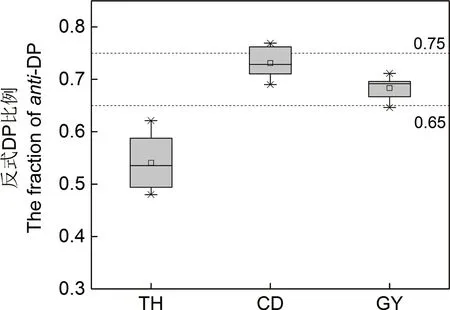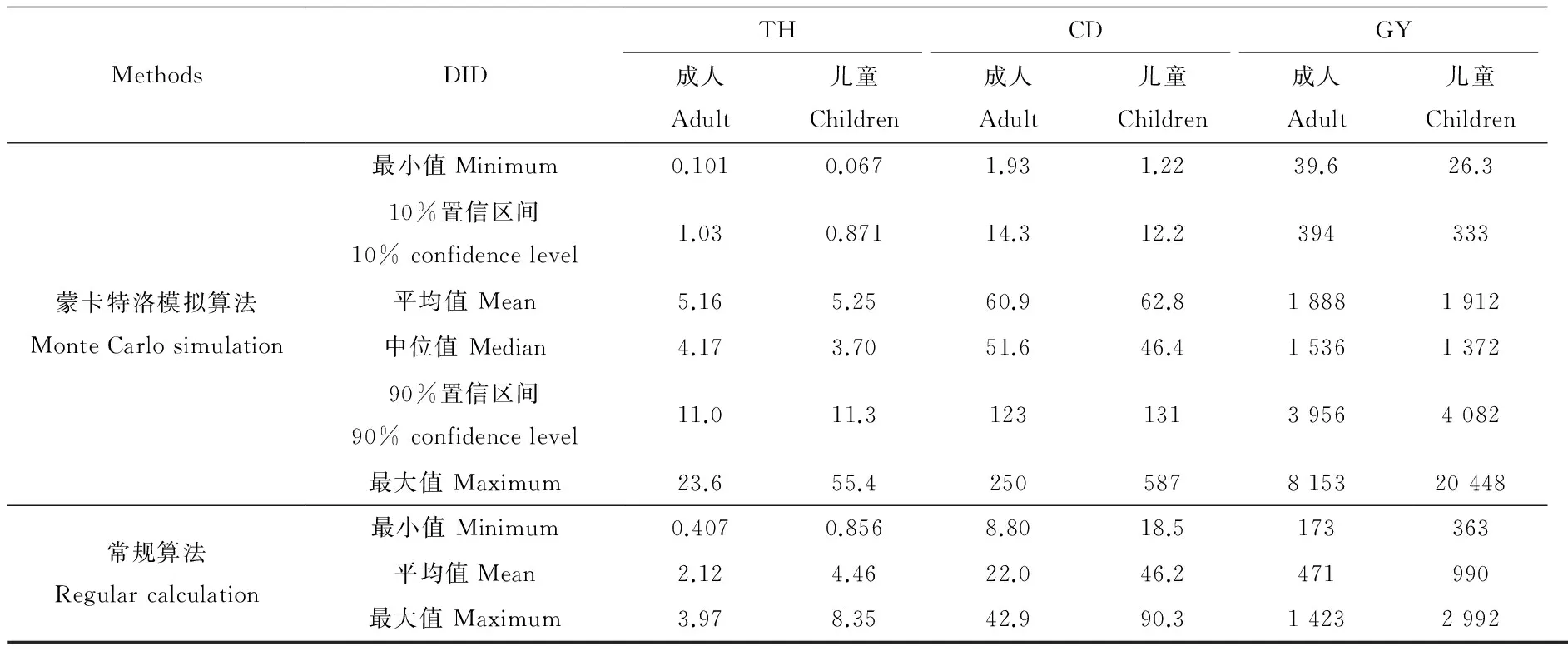电子垃圾拆解区及其周边大气中得克隆的污染和呼吸暴露研究
刘合欢,李会茹,盛国
1,彭平安1
1. 中国科学院广州地球化学研究所 有机地球化学国家重点实验室和广东省环境资源利用与保护重点实验室,广州 510640 2. 中国科学院大学,北京 100049
电子垃圾拆解区及其周边大气中得克隆的污染和呼吸暴露研究

1,彭平安1
1. 中国科学院广州地球化学研究所 有机地球化学国家重点实验室和广东省环境资源利用与保护重点实验室,广州 510640 2. 中国科学院大学,北京 100049
添加型高氯代阻燃剂得克隆(dechlorane plus, DP)因为在环境中表现出普遍存在性、持久性、生物富集性、长距离迁移性和毒性,近年来迅速引起各国环境科学家的关注和重视。DP广泛应用于电线电缆等电子产品塑料中,粗放式电子垃圾拆解活动已被证实是环境中DP的重要污染来源之一。为探讨电子垃圾拆解区及其周边地区大气中DP的污染特征、呼吸暴露剂量和影响因素,对典型电子垃圾拆解区贵屿(GY)及其周边地区陈店(CD)和对照市区(广州市天河区,TH)进行大气采样和DP分析,并运用Monte Carlo模拟计算其日呼吸摄入剂量,同时对暴露参数进行了灵敏度分析。结果表明:受当地粗放式电子垃圾拆解活动的影响,GY大气中的DP平均浓度(范围)高达(1 119±1 021) pg·m-3(410~3 381 pg·m-3),远高于CD (52.2±30.2, 20.9~102 pg·m-3)和TH (5.04±2.73, 0.967~9.43 pg·m-3);受GY大气污染扩散迁移的影响,CD大气中的DP浓度也显著高于TH (t-test, P=0.006);GY大气中反式DP的比例(fanti)与DP商业品(fanti=0.70)无显著差异(t-test, P=0.08),这与其存在本地排放源一致,而TH大气中的fanti显著低于DP商业品(t-test, P=0.000);3个地区居民的DP日均呼吸摄入剂量(pg·kg-1·d-1)分别为:GY成人1 888,儿童1 912;CD成人60.9,儿童62.8;TH成人5.16,儿童5.25;呼吸速率是DP日呼吸摄入剂量的主要贡献因子,其次为大气中的DP浓度和体重,体重对于儿童的影响远高于成人。上述研究结果表明GY及其周边地区居民均处于较高DP呼吸暴露风险中。
氯代阻燃剂;得克隆;电子垃圾;大气气溶胶;呼吸暴露
Received 24 November 2015 accepted 23 December 2015
得克隆(dechlorane plus, DP)即双(六氯环戊二烯)环辛烷(C18H12Cl12),也叫敌可燃,是一类高度氯化的脂环族阻燃剂(Cl%=65%),由Hooker Chemical公司在19世纪60年代推出,用以取代与其结构类似的持久性有机污染物(persistent organic pollutants, POPs)灭蚁灵(mirex)。DP具有良好的着色性、热稳定性、优异的电学性能及低生烟量等一系列优点,被广泛用于纺织、电子电器和家具装修材料中[1]。目前已知的DP生产厂家有北美OxyChem化学公司(1968年收购了Hooker Chemical公司)和我国安邦电化公司,其中OxyChem公司近50年来DP的年产量为450 t,被美国国家环境保护署(USEPA)列为高产量物质(年产量>100万磅);我国安邦电化公司自2003年起开始生产DP,年产量在300~3 000 t之间[2]。DP为添加型阻燃剂,与相应的高分子聚合物之间无化学键作用,在其相关产品的生产、使用和回收过程中易释放进入环境[3],但环境中的DP自其被使用以来并未引起关注。2006年Hoh等[4]首次报道了五大湖地区环境中的DP,此后DP的污染来源、环境浓度、行为和毒性迅速引起人们的重视。迄今为止,DP已在世界各地的水体、土壤、大气及生物体等多种环境介质和人体样品中被检出[5-6],且在环境中表现出持久存在性、远距离迁移性、生物富集性、潜在的生物毒性等POPs特性,可能被加入POPs公约附件D的考察清单[5]。
研究表明,电子垃圾拆解活动、城市活动和DP相关产品的生产使用过程是环境中DP的重要污染来源[5-6]。为节省成本,我国一些地区采用手工拆解、烘烤、焚烧、酸洗等原始粗放式手段回收电子垃圾中的金属、塑料等材料[7],对当地环境造成了严重污染。由于DP在电子产品中的广泛应用,电子垃圾拆解区各类环境介质中都呈现出较高的DP浓度[8-24]。电子垃圾拆解作坊内灰尘中DP的浓度均值(范围)为1 515 (343~4 197) ng·g-1,比对照城市室内灰尘浓度(18.9, 2.78~70.4 ng·g-1)高出两个数量级[14];拆解区大气中的DP浓度在13.1~1 794 pg·m-3之间,显著高于对照区(0.47~35.7 pg·m-3)[15];拆解点表层土壤[16]中DP的浓度最高值(3 327 ng·g-1)与DP生产基地周围土壤中[17]的DP浓度(1 490±3 580 ng·g-1干重)接近,远高于其周边地区(n.d.~47.4 ng·g-1)和珠三角典型工业区(0.03~4.65 ng·g-1)[16];电子垃圾拆解区附近区域水和沉积物中的DP平均浓度分别达到(0.8±0.06) ng·L-1和7 590 ng·g-1dw[24]。与此同时,高浓度的DP也在电子垃圾拆解区各类生物样品中被检出,其中包括树叶(0.45~51.9 ng·g-1dw)[15]、水稻(0.71~1.99 ng·g-1dw)[18]、陆生鸟类(n.d.~500 ng·g-1lw)[19]、水生鸟类(n.d.~2 200 ng·g-1lw )[20]、鱼螺等水生生物(n.d. ~1 670 ng·g-1lw)[9, 21]、蚯蚓(3.43~89.2 ng·g-1lw)[22]、青蛙(2.01~291 ng·g-1lw)[23]等。
环境介质中的DP可通过呼吸、饮食、皮肤接触、灰尘吸入等多种暴露途径进入人体。研究表明,电子垃圾拆解区居民人体样品中的DP浓度要显著高于其他对照地区[14, 25-29],拆解区人体血清中的DP平均浓度达到42.6 ng·g-1,约为邻近地区(13.7 ng·g-1)的3倍[25];母乳样品中的DP浓度为2.19~4.46 ng·g-1lw,明显高于城市地区(0.98 ng·g-1lw)[27];人体头发中的DP浓度(0.19~35.7 ng·g-1)也远高于普通城市地区(0.02~4.97 ng·g-1)[14]。目前对于电子垃圾拆解区环境中的DP及其居民的DP内外暴露水平都有一定研究,但对DP的具体暴露途径、剂量和影响因素等讨论较少,对典型电子垃圾拆解区贵屿(Guiyu, GY)大气中的DP污染尚未见报道。本文选取GY及其周边地区和普通城市对照区进行大气采样和DP分析,采用Monte Carlo模拟对研究区域居民的DP日呼吸暴露剂量进行计算,并对计算结果的不确定性和影响因素进行了分析。
1 材料与方法 (Materials and methods)
1.1 采样点及样品采集
GY镇地处广东省汕头市潮阳区西部,支柱产业是电子垃圾拆解业。GY早在19世纪80年代末期就开始涉及旧五金电器的拆解生意。由于获利丰厚,整个行业规模逐渐扩大,90年代初真正发展为GY主业。与此同时,国外电子垃圾通过转运点开始大规模进入GY。约80%的GY家庭参与该行业,年拆解垃圾量超过100万t[30]。陈店镇(Chendian, CD)距离GY镇9 km左右,支柱产业是商业贸易和内衣家居服装。广州地处华南,为我国第三大城市和金融中心,城市对照采样点位于广州市天河区(Tianhe, TH)。
环境大气样品采集于2005-12-18至2006-1-3期间,采样期间无降雨降雪天气。大气中的总悬浮颗粒物(total suspended particles, TSP)采用智能大流量空气采样器(武汉天虹智能仪表厂)和Whatman玻璃纤维膜(Glass fiber filters, GFFs, 20.3 cm×5.4 cm)收集,采样设定流量1.05 m3·min-1。采样前用无水乙醇或丙酮清洗采样器内壁及压框,采样结束后GFF用铝箔包裹并装入样品袋密封,置于<-20 ℃冰箱中保存待用。样品采集前后分别用流量校正器(武汉天虹智能仪表厂)进行流量校正。每个样品连续采样8 h以上,采样体积大于400 m3。本研究共采集到22个样品,其中GY8个、CD7个、TH7个。
1.2 溶剂与试剂
顺式(anti-)DP和反式(syn-)DP标准溶液(50 μg·mL-1,纯度>95%)购自Wellington Laboratories (Guelph, ON, Canada)。分析过程中所使用的溶剂和试剂均为分析纯或农残级。硅胶(70~230目)和氧化铝(60~100目)分别购自美国Aldrich公司和德国Merck公司,使用前分别在180 ℃和250 ℃条件下活化24 h,冷却后加3%(w:w)蒸馏水去活化,平衡12 h后加入正己烷并置于干燥器中备用。无水硫酸钠在450 ℃下烘烤4 h后置于干燥器中保存待用。
1.3 样品前处理
作为Festo首款独家数字化产品,Smartenance是一款基于云端的APP,所有制造企业均可使用。该应用程序引导清晰明确,因此设置更快捷。生产经理用户界面可便利地用浏览器打开。Smartenance让终端用户能计划、监控和评估系统维护。数字化的维护计划让维护更简单、更快速、更可靠,为系统操作员与生产经理的复查提高了可靠性,省却了许多过程和协调工作。
样品中加入13C标记的PCB-141和PCB-209,用正己烷-丙酮(V:V=1:1)混合溶剂索氏抽提48 h。提取液经无水硫酸钠除水后旋转蒸发,转换溶剂至正己烷并浓缩至1 mL左右。浓缩液采用多段氧化铝/硅胶柱(1 cm i.d.)进行净化,湿法装柱从下至上分别为6 cm氧化铝、2 cm中性硅胶、5 cm碱性硅胶(1 mol·L-1NaOH, w:w, 33%)、2 cm中性硅胶、8 cm酸性硅胶(硅胶:硫酸= 2:1, w:w)和2 cm无水硫酸钠,样品上柱后分别用15 mL正己烷和70 mL正己烷-二氯甲烷(V:V=1:1)混合溶剂洗脱,收集后者并旋转蒸发浓缩至100 μL,加入进样内标13C-PCB-208后进行仪器分析。
1.4 仪器分析
负离子化学源气相色谱-质谱联用仪(NCI-GC-MS, Agilent 7890A-5975C),选择离子扫描模式,载气为氦气,无分流模式进样1 μL;15-m DB-5-HT MS毛细管柱(250 μm i.d. 0.10 μm, J&W Science, Folsom, CA, 美国),柱升温程序:110 ℃保持5 min,20 ℃·min-1升温至200 ℃,保持4.5 min,再以7.5 ℃·min-1升温至300 ℃,保持16 min;进样口、传输线、离子源和四极杆的温度分别为260 ℃、280 ℃、250 ℃和150 ℃;DP化合物监测离子对(m/z)为651.7和653.7。
1.5 质量控制与质量保证(QA/QC)
GFF使用前于450 ℃马弗炉中烘烧4 h以去除背景有机物干扰。所有样品中均加入回收率指示物以衡量萃取净化效率,每12个样品包含一个野外采样空白、一个实验室空白、一个空白加标和一个基质加标对分析流程进行质量控制,以确保分析结果的准确性和可靠性。当目标物与标准物质保留时间误差在±0.1 min之内,信噪比(S/N)≥10,且监测离子对同位素比值与理论值误差在15%以内才能对其进行识别与定量。浓度计算采用8点标准曲线。所有样品中13C-PCB-141和PCB-209的回收率分别在72%~125%和77%~132%之间,空白/基质加标样品中DP化合物的回收率为80%~117%。样品数据的统计分析均在SPSS v20软件上运行,置信度P =0.05。
1.6 Monte Carlo模拟和灵敏度分析
为评价各研究区域居民对DP的呼吸暴露风险,本研究根据美国EPA暴露因子手册中推荐的评价方法和计算公式[31],对DP的日呼吸摄入剂量(daily inhalation intake dose, DID)进行计算:
DID (pg·kg-1·d-1) = C × IR/BW
对相关参数进行定义和计算,相关变量及分布模型参数见表1。Monte Carlo模拟在Oracle Crystal Ball(Release 11.1.2.500)软件上运行,采样次数为100 000次。
2 结果与讨论(Results and discussion)
2.1 研究区域大气中的DP浓度
DP化合物亲脂性强(log Kow=9.3),正辛醇-空气分配系数较高(log Koa=14),大气中的DP约99%左右存在于颗粒相上,仅有约1%以气态形式存在[4],因此可认为颗粒相DP浓度近似等于DP的大气浓度。顺反式DP在本研究所有大气样品中被检出,检出率100%,说明DP在所研究区域大气中普遍存在。各研究区域大气中DP总浓度的平均值±标准偏差(范围)分别为:(1 119±1 021) pg·m-3(410~3 381 pg·m-3)(GY)、(52.2±30.2) pg·m-3(20.9~102 pg·m-3) (CD)和(5.04±2.73) pg·m-3(0.967~9.43 pg·m-3) (TH),空间分布上呈现出电子垃圾拆解区GY > 电子垃圾拆解区周边地区CD > 城市地区TH的变化规律(图1)。

图1 贵屿(GY)、陈店(CD)和广州市天河区(TH)大气中的DP浓度Fig. 1 The concentrations of DP in air around Guiyu (GY), Chendian (CD) and Tianhe District of Guangzhou (TH)

表1 得克隆(DP)呼吸暴露剂量计算相关变量的分布模型及参数
注:* min表示最小值,max表示最大值,μ表示平均值,δ表示标准差;** BW符合正态分布规律,但实际体重需增加最大值和最小值限定以保证取值具有实际意义。
Note:*min, max, μ and δ represent minimum, maximum, mean and standard deviation, respectively;** BW is normally distributed, and the minimum and maximum were added to ensure all data are reasonable.
目前对世界不同地区大气中的DP研究较多,表2列出了国内外不同城市和地区大气中的DP浓度,平均值在0.38[45]~44.8[46]pg·m-3之间。相比之下,TH大气中的DP浓度与我国上海[42]和哈尔滨[43]相近,略低于Ren等[44]报道的我国21个城市地区的浓度,与世界其他国家和城市地区相比处于中等水平。GY地区以电子垃圾拆解为主业,没有其他工业,也没有涉及DP及相关产品的生产制造,但其大气中的DP浓度约为城市对照区TH的200倍,显著高于世界其他城市地区(表2),与我国江苏淮安DP生产厂附近大气中的DP浓度接近[47],说明该地区粗放式的电子垃圾拆解活动向环境中释放了大量的DP,从而造成该地区严重的DP污染。CD是距离GY约9 km的一个小镇,以内衣家居服制造为主业,没有电子垃圾拆解点,也没有涉及DP及其相关产品的生产制造,但CD大气中的DP浓度比典型城市地区TH高出一个数量级,也显著高于我国其他城市地区(15.6±15.1 pg·m-3)[44](表2),由此可以推断,GY大气中严重的DP污染通过大气迁移对CD产生了影响。

表2 世界不同城市和地区大气中的DP浓度(pg·m-3)

图2 DP的合成反应Fig. 2 The synthesis reaction of DP

图3 贵屿(GY)、陈店(CD)和广州天河区(TH)大气中anti-DP的比例Fig. 3 The fractions of anti-DP in atmosphere from Guiyu (GY), Chendian (CD) and Tianhe District of Guangzhou (TH)
我国广东浙江等地均存在与GY类似的电子垃圾拆解区。Chen等[15]报道了广东清远电子垃圾拆解点大气中的DP平均浓度(范围)为363 (13.1~1 794) pg·m-3,显著高于距离拆解点25 km的对照区(5.65, 0.47~35.7 pg·m-3)。浙江某电子垃圾拆解地大气中的DP浓度[48]为11.6 pg·m-3。与上述电子垃圾拆解区相比,GY大气中的DP浓度较高,这可能与GY地区前期主要拆解进口电子垃圾的电线电缆和电脑组件有关。我国电子产品中添加的卤系阻燃剂以溴代阻燃剂为主,尤其是十溴联苯醚(Deca-BDEs, BDE-209),对DP的生产和使用量远小于欧美国家,因此,我国环境中的PBDEs浓度普遍比DP高两到三个数量级[49-50]。但因为电子洋垃圾的输入,我国电子垃圾拆解区环境中表现出较高的DP浓度:GY大气中的DP浓度达到BDE-209浓度(2 164 pg·m-3)的一半[50];GY人体血清中的DP浓度(均值39.8 ng·g-1脂重)也约为BDE-209(均值70.6 ng·g-1脂重)的一半[25]。GY地区环境中DP与BDE-209浓度比例的升高证实了电子洋垃圾是该地区DP污染的主要来源。
2.2 DP异构体组成
DP由1,5-环辛二烯和六氯环戊二烯以2:1的摩尔比通过Diels-Alder环化反应合成,产物包括syn-DP和anti-DP两种异构体(见图2)。不同DP商业品在颗粒尺寸上会存在差异,但其异构体组成比例恒定,syn-DP:anti-DP近似等于1:3,即anti-DP的浓度比例(fanti)约为75%[4-5]。但因为生产厂家和生产批次之间的差异,目前文献中报道的DP商业品fanti值稍有差别。Hoh等[4]和Qiu等[51]报道的DP商业品fanti值分别为0.75~0.80和0.75,Tomy等[44]报道美国Oxychem公司DP产品中的fanti值为0.65,Wu等[52]对我国生产的DP商业品分析后测得fanti值为0.70±0.003,此外0.59[53]、0.60[17]、0.68[3]等也都有报道,但总体来说DP商业品的fanti值基本在0.60~0.80范围内。
从结构上看(图2),anti-DP环辛烷结构内部的4个碳原子受氯原子和环戊二烯结构的屏蔽程度低于syn-DP,理论上反应活性比syn-DP强,而syn-DP则相对稳定[4]。实际研究中也发现anti-DP在大气迁移过程中会发生选择性降解或者可能向syn-DP转化,从而导致fanti降低[4, 54-55],但Qiu等[51]对五大湖区沉积物柱状样的研究发现沉积年龄越长,样品的fanti值越高,说明沉积物/土壤中的syn-DP容易在微生物作用下发生降解[6, 51]。2种异构体在生物体中的情况更为复杂,已有研究表明syn-DP在水生生物体内可发生选择性富集,但2种异构体在陆生生物和人体内表现出的生物富集性没有显著差异[6]。鉴于2种异构体不同的空间构型、理化性质和环境行为,实际研究中常通过考察anti-DP或syn-DP浓度比例与DP商业品之间的差异来探讨2种异构体在环境中的迁移行为和归趋。
本文3个研究地区大气中的fanti值如图3所示。GY、CD和TH的fanti平均值(范围)分别为0.68±0.02(0.65~0.71)、0.73±0.03(0.69~0.77)和0.54±0.05(0.48~0.62),其中GY的结果与Chen等[15]对清远电子垃圾区大气的研究结果相同(fanti=0.726±0.037)。本研究采用0.70作为DP商业品的fanti值对样本进行了t检验,结果表明,GY大气中DP的fanti值与DP商业品之间没有显著差异(P=0.08),再次说明了GY当地存在DP的污染排放源;CD地区的fanti值与商品级DP的fanti值接近(图 3),结合CD距离GY较近且当地不存在DP生产使用及电子垃圾拆解等污染源,这一结果进一步证实了CD大气中的DP主要来源于GY地区DP重污染的大气迁移;TH大气中DP的fanti值则显著低于DP商业品(t-test, P=0.000),也低于我国其他城市和地区大气的fanti值[42-44]。除DP生产和电子垃圾拆解活动外,含DP产品的使用[62]、城市活动[63]和点源污染的大气迁移[51]也是环境中DP的重要来源。TH区是典型城市地区,但其大气中的DP浓度(5.04±2.73 pg·m-3)与我国郊区和乡村地区的浓度(3.5±5.6 pg·m-3)接近[44],且其fanti值显著偏低,由此推断本地城市活动及含DP产品的生产使用对TH大气中的DP贡献较小,点源污染的大气迁移是其主要来源,且anti-DP在迁移过程中发生了选择性降解或转化,从而使样品中的fanti值低于商品级DP的fanti值[64]。
2.3 呼吸暴露
目前DP在各类环境介质[62, 65]以及人体样品中[3, 29]被广泛检出,尽管还没有关于人体在DP暴露下急性中毒的案例,但对斑马鱼[66]、蚯蚓[67]和大型藻[68]等的研究表明,DP会对这些生物的生理机能造成伤害。环境中的DP能够通过呼吸、皮肤接触和饮食等途径进入人体并累积,可能会对人体造成不利的影响,因此有必要对不同暴露途径DP的人体暴露剂量和影响因素进行评价。
本研究根据美国EPA的呼吸暴露剂量计算公式及我国人群暴露参数对研究区域居民对DP的DIDs进行了Monte Carlo模拟计算,同时采用参数平均值(最小值,最大值)和常规算法计算以进行比较,结果如表3所示。根据Monte Carlo模拟计算结果,GY、CD和TH成人对DP的DID均值(范围)分别为1 888 (39.6~8 153) pg·kg-1·d-1、60.9 (1.93~250) pg·kg-1·d-1和5.16 (0.101~23.6) pg·kg-1·d-1;GY、CD和TH儿童的DID均值(范围)分别为1 912 (26.3~20 448) pg·kg-1·d-1、62.8 (1.22~587) pg·kg-1·d-1和5.25 (0.067~55.4) pg·kg-1·d-1,显而易见,同地区儿童对DP的DIDs要略高于成人。相比之下,常规算法的计算结果均低于Monte Carlo模拟结果,且两者差距随大气中DP浓度的增大而增大,此外,常规算法的计算结果表明同地区儿童对DP的DIDs约为成人的2倍左右(表 3),可见采用平均值常规计算的不确定性很大。而Monte Carlo模拟计算考虑了各暴露因素的实际变化情况和概率,能有效地减少这种不确实性,获得较为准确的结果。Wang等[69]对DP呼吸暴露剂量的计算表明,清远电子垃圾区居民的DP呼吸暴露剂量为2.1 pg·kg-1·d-1(成人)和3.2 pg·kg-1·d-1(儿童),该结果与本研究中城市对照区TH的数据接近,但远低于GY电子垃圾拆解区的计算结果。同为电子垃圾拆解区,且均采用Monte Carlo模拟算法,但计算结果存在较大差异,主要原因可能为:(1)计算所采用大气中DP的浓度存在较大差异。Wang等[69]分别采用Chen等[15]报道的清远电子垃圾拆解点和距离拆解点20 km对照区大气中的DP浓度(分别为363 pg.m-3和5.65 pg.m-3)对拆解工人和居民的DP呼吸暴露剂量进行计算,后者与本研究中TH的浓度接近,GY环境大气中的DP浓度约为其200倍;(2) 计算选用的暴露参数存在较大差异。Wang等[69]采用美国EPA的暴露参数进行计算,本研究依据侯捷等[41]报道的我国居民暴露数据对相关计算参数进行定义和计算。

表3 不同算法下贵屿(GY)、陈店(CD)和广州天河区(TH)居民的DP日呼吸暴露剂量(DID, pg·kg-1·d-1)

图4 不同暴露参数(C、IR和BW)对DP日呼吸暴露剂量(DID)的贡献率 (GY、CD和TH分别为贵屿、陈店和广州市天河区)Fig. 4 The contributions of C, IR and BW to the daily inhalation exposure dose (DID) of DP (GY, CD and TH stand for Guiyu, Chendian, and Tianhe District of Guangzhou, respectively)
此外,本研究对大气中的DP浓度、呼吸速率、体重等参数对DP日呼吸暴露剂量的影响进行了灵敏度分析,各参数的贡献因子如图4所示。由图4可知,呼吸速率是各区域居民DP呼吸暴露剂量的主要贡献因子(47.2%~67.9%),其次为大气中的DP浓度(23.6%~42.8%)和体重(0.9%~23.1%)。体重对于成人的DP呼吸剂量贡献较小,贡献因子在0.9%~1.2%之间,但对儿童的DP呼吸剂量贡献较大,贡献因子达到19.0%~23.1%,表明体重对于儿童的DP呼吸暴露风险更为重要,这也是Monte Carlo模拟和常规计算在儿童DIDs计算结果上存在差异的主要原因。与各地区大气中DP的浓度变化趋势一致,GY和CD居民对DP的DIDs显著高于TH地区,表明电子垃圾拆解及其周边地区居民处于较高的DP呼吸暴露风险中。Wang等[69]对DP生产地区及电子垃圾拆解区人体暴露风险的研究表明,饮食暴露是人体DP暴露的主要方式,约占99%以上,因此未来应对贵屿及其周边地区开展饮食、皮肤接触等暴露途径、剂量和影响因素的研究,以全面评估该地区居民的DP暴露风险。
[1] 李宇霖, 孟祥周, 赵丽芳, 等. 环境中新兴有机污染物得克隆的研究进展[J]. 环境科学与技术, 2012, 35(2): 79-83
Li Y L, Meng X Z, Zhao L F, et al. Progress on dechlorane plus, an emerging organic pollutant in environment [J]. Enuivonmental Science and Technology, 2012, 35(2): 79-83 (in Chinese)
[2] 何畅, 金军, 马召辉, 等. 青海省西宁市与天峻县大气中得克隆与十溴联苯醚的水平与来源[J]. 环境科学, 2013, 34(3): 1129-1135
He C, Jin J, Ma Z H, et al. Levels and sources of decabromodiphenyl ether and dechlorane plus in Xining and Tianjun, Qinghai Province, China [J]. Environmental Sciences, 2013, 34(3): 1129-1135 (in Chinese)
[3] Zhang H, Wang P, Li Y, et al. Assessment on the occupational exposure of manufacturing workers to dechlorane plus through blood and hair analysis [J]. Environmental Science & Technology, 2013, 47(18): 10567-10573
[4] Hoh E, Zhu L Y, Hites R A. Dechlorane plus, a chlorinated flame retardant, in the Great Lakes [J]. Environmental Science & Technology, 2006, 40(4): 1184-1189
[5] Sverko E, Tomy G T, Reiner E J, et al. Dechlorane plus and related compounds in the environment: A review [J]. Environmental Science & Technology, 2011, 45(12): 5088-5098
[6] Xian Q, Siddique S, Li T, et al. Sources and environmental behavior of dechlorane plus--A review [J]. Environmental International, 2011, 37(7): 1273-1284
[7] 傅建捷, 王亚韡, 周麟佳, 等. 我国典型电子垃圾拆解地持久性有毒化学污染物污染现状[J]. 化学进展, 2011, 23(8): 1755-1768
Fu J J, Wang Y W, Zhou L J, et al. Pollution status and perspectives of persistent toxic substances in e-waste dismantling area in China [J]. Progress in Chemistry, 2011, 23(8): 1755-1768 (in Chinese)
[8] Zheng X B, Luo X J, Zeng Y H, et al. Sources, gastrointestinal absorption and stereo-selective and tissue-specific accumulation of dechlorane plus (DP) in chicken [J]. Chemosphere, 2014, 114: 241-246
[9] Wu J P, She Y Z, Zhang Y, et al. Sex-dependent accumulation and maternal transfer of dechlorane plus flame retardant in fish from an electronic waste recycling site in South China [J]. Environmental Pollution, 2013, 177: 150-155
[10] Zheng X B, Wu J P, Luo X J, et al. Halogenated flame retardants in home-produced eggs from an electronic waste recycling region in South China: Levels, composition profiles, and human dietary exposure assessment [J]. Environment International, 2012, 45: 122-128
[11] Mo L, Wu J P, Luo X J, et al. Dechlorane plus flame retardant in kingfishers (Alcedo atthis) from an electronic waste recycling site and a reference site, South China: Influence of residue levels on the isomeric composition [J]. Environmental Pollution, 2013, 174: 57-62
[12] Tao W, Zhou Z, Shen L, et al. Determination of dechlorane flame retardants in soil and fish at Guiyu, an electronic waste recycling site in South China [J]. Environmental Pollution, 2015, 206: 361-368
[13] Zeng Y H, Luo X J, Zheng X B, et al. Species-specific bioaccumulation of halogenated organic pollutants and their metabolites in fish serum from an e-waste site, South China [J]. Archives of Environmental Contamination and Toxicology, 2014, 67(3): 348-357
[14] Zheng J, Wang J, Luo X J, et al. Dechlorane plus in human hair from an e-waste recycling area in South China: Comparison with dust [J]. Environmental Science & Technology, 2010, 44(24): 9298-9303
[15] Chen S J, Tian M, Wang J, et al. Dechlorane plus (DP) in air and plants at an electronic waste (e-waste) site in South China [J]. Environmental Pollution, 2011, 159(5): 1290-1296
[16] Yu Z, Lu S, Gao S, et al. Levels and isomer profiles of dechlorane plus in the surface soils from e-waste recycling areas and industrial areas in South China [J]. Environmental Pollution, 2010, 158(9): 2920-2925
[17] Wang D G, Yang M, Qi H, et al. An Asia-specific source of dechlorane plus: Concentration, isomer profiles, and other related compounds [J]. Environmental Science & Technology, 2010, 44(17): 6608-6613
[18] She Y Z, Wu J P, Zhang Y, et al. Bioaccumulation of polybrominated diphenyl ethers and several alternative halogenated flame retardants in a small herbivorous food chain [J]. Environmental Pollution, 2013, 174: 164-170
[19] Yu L H, Luo X J, Zheng X B, et al. Occurrence and biomagnification of organohalogen pollutants in two terrestrial predatory food chains [J]. Chemosphere, 2013, 93(3): 506-511
[20] Zhang X L, Luo X J, Liu H Y, et al. Bioaccumulation of several brominated flame retardants and dechlorane plus in waterbirds from an e-waste recycling region in South China: Associated with trophic level and diet sources [J]. Environmental Science & Technology, 2011, 45(2): 400-405
[21] Zhang Y, Luo X J, Wu J P, et al. Contaminant pattern and bioaccumulation of legacy and emerging organhalogen pollutants in the aquatic biota from an e-waste recycling region in South China [J]. Environmental Toxicology and Chemistry, 2010, 29(4): 852-859
[22] Xiao K, Wang P, Zhang H D, et al. Levels and profiles of dechlorane plus in a major e-waste dismantling area in China [J]. Environmental Geochemistry and Health, 2013, 35(5): 625-631
[23] Li L, Wang W Y, Lv Q X, et al. Bioavailability and tissue distribution of dechloranes in wild frogs (Rana limnocharis) from an e-waste recycling area in Southeast China [J]. Journal of Environmental Sciences-China, 2014, 26(3): 636-642
[24] Wu J P, Zhang Y, Luo X J, et al. Isomer-specific bioaccumulation and trophic transfer of dechlorane plus in the freshwater food web from a highly contaminated site, South China [J]. Environmental Science & Technology, 2005, 44(2): 606-611
[25] Ren G, Yu Z, Ma S, et al. Determination of dechlorane plus in serum from electronics dismantling workers in South China [J]. Environmental Science & Technology, 2009, 43(24): 9453-9457
[26] Yan X, Zheng J, Chen K H, et al. Dechlorane plus in serum from e-waste recycling workers: Influence of gender and potential isomer-specific metabolism [J]. Environmental International, 2012, 49: 31-37
[27] Ben Y J, Li X H, Yang Y L, et al. Dechlorane plus and its dechlorinated analogs from an e-waste recycling center in maternal serum and breast milk of women in Wenling, China [J]. Environmental Pollution, 2013, 173: 176-181
[28] Yang Q Y, Qiu X H, Li R, et al. Exposure to typical persistent organic pollutants from an electronic waste recycling site in Northern China [J]. Chemosphere, 2013, 91(2): 205-211
[29] Chen K H, Zheng J, Yan X, et al. Dechlorane plus in paired hair and serum samples from e-waste workers: Correlation and differences [J]. Chemosphere, 2015, 123: 43-47
[30] 绿色和平组织. 汕头贵屿电子垃圾拆解业的人类学调查报告[EB/OL]. 2003. http://www.greenpeace.org/china/Global/china/_planet-2/report/2007/11/guiyu-report.pdf.
Greenpeace China. Anthropologic Report of the Electric Wastes Dismantling Industry in Guiyu, Shantou, China [EB/OL]. 2003. http://www.greenpeace.org/china/Global/china/_planet-2/report/2007/11/guiyu-report.pdf.
[31] The National Center for Environmental Assessment. Exposure Factors Handbook [S]. 1997
[32] Zolezzi M, Cattaneo C, Tarazona J V. Probabilistic ecological risk assessment of 1,2,4-trichlorobenzene at a former industrial contaminated site [J]. Environmental Science & Technology, 2005, 39(9): 2920-2926
[33] Viau E J, Lee D, Boehm A B. Swimmer risk of gastrointestinal illness from exposure to tropical coastal waters impacted by terrestrial dry-weather runoff [J]. Environmental Science & Technology, 2011, 45(17): 7158-7165
[34] Traas T P, Stab J A, Kramer P R G, et al. Modeling and risk assessment of tributyltin accumulation in the food web of a shallow freshwater lake [J]. Environmental Science & Technology, 1996, 30(4): 1227-1237
[35] Teunis P F M, Xu M, Fleming K K, et al. Enteric virus infection risk from intrusion of sewage into a drinking water distribution network [J]. Environmental Science & Technology, 2010, 44(22): 8561-8566
[36] Schenker U, Scheringer M, Sohn M D, et al. Using information on uncertainty to improve environmental fate modeling: A case study on DDT [J]. Environmental Science & Technology, 2009, 43(1): 128-134
[37] Ritter R, Scheringer M, Macleod M, et al. Assessment of nonoccupational exposure to DDT in the tropics and the North: Relevance of uptake via inhalation from indoor residual spraying [J]. Environmental Health Perspectives, 2011, 119(5): 707-712
[38] Masago Y, Katayama H, Watanabe T, et al. Quantitative risk assessment of noroviruses in drinking water based on qualitative data in Japan [J]. Environmental Science & Technology, 2006, 40(23): 7428-7433
[39] Kooistra L, Huijbregts M A J, Ragas A M J, et al. Spatial variability and uncertainty in ecological risk assessment: A case study on the potential risk of cadmium for the little owl in a Dutch river flood plain [J]. Environmental Science & Technology, 2005, 39(7): 2177-2187
[40] Choi K W, Lee J H W, Kwok K W H, et al. Integrated stochastic environmental risk assessment of the harbour area treatment scheme (HATS) in Hong Kong [J]. Environmental Science & Technology, 2009, 43(10): 3705-3711
[41] 侯捷, 曲艳慧, 宁大亮, 等. 我国居民暴露参数特征及其对风险评估的影响[J]. 环境科学与技术, 2014, 37(8): 179-187
Hou J, Qu Y H, Ning D L, et al. Characteristic of human exposure factors in China and their uncertainty analysis in health risk assessment [J]. Envivoronmental Science and Technology, 2014, 37(8): 179-187 (in Chinese)
[42] Yu Z, Liao R, Li H, et al. Particle-bound dechlorane plus and polybrominated diphenyl ethers in ambient air around Shanghai, China [J]. Environmental Pollution (Barking, Essex: 1987), 2011, 159(10): 2982-2988
[43] Ma W L, Liu L Y, Qi H, et al. Dechlorane plus in multimedia in northeastern Chinese urban region [J]. Environment International, 2011, 37(1): 66-70
[44] Ren N, Sverko E, Li Y F, et al. Levels and isomer profiles of dechlorane plus in Chinese air [J]. Environmental Science & Technology, 2008, 42(17): 6476-6480
[45] Wang L, Jia H L, Liu X J, et al. Dechloranes in a river in northeastern China: Spatial trends in multi-matrices and bioaccumulation in fish (Enchelyopus elongatus) [J]. Ecotoxicology and Environmental Safety, 2012, 84: 262-267
[46] Baek S Y, Jurng J, Chang Y S. Spatial distribution of polychlorinated biphenyls, organochlorine pesticides, and dechlorane plus in Northeast Asia [J]. Atmospheric Environment, 2013, 64: 40-46
[47] Zhang Q H, Zhu C F, Zhang H D, et al. Concentrations and distributions of dechlorane plus in environmental samples around a dechlorane plus manufacturing plant in East China [J]. Science Bulletin, 2015, 60(8): 792-797
[48] 禹甸, 鲜啟鸣. 电子垃圾回收地得克隆的污染水平及分布特征[J]. 环境监控与预警, 2014, 6(3): 36-43
Yu D, Xian Q M. Levels and spatial distribution of dechlorane plus in electronic waste recycling site [J]. Environmental Monitoring and Forewarning, 2014, 6(3): 36-43 (in Chinese)
[49] Chen D, Bi X, Liu M, et al. Phase partitioning, concentration variation and risk assessment of polybrominated diphenyl ethers (PBDEs) in the atmosphere of an e-waste recycling site [J]. Chemosphere, 2011, 82(9): 1246-1252
[50] Chen D, Bi X, Zhao J, et al. Pollution characterization and diurnal variation of PBDEs in the atmosphere of an e-waste dismantling region [J]. Environmental Pollution, 2009, 157(3): 1051-1057
[51] Qiu X, Marvin C H, Hites R A. Dechlorane plus and other flame retardants in a sediment core from Lake Ontario [J]. Environmental Science & Technology, 2007, 41(17): 6014-6019
[52] Wu J P, Zhang Y, Luo X J, et al. Isomer-specific bioaccumulation and trophic transfer of dechlorane plus in the freshwater food web from a highly contaminated site, South China [J]. Environmental Science & Technology, 2010, 44(2): 606-611
[53] Zeng L, Yang R, Zhang Q, et al. Current levels and composition profiles of emerging halogenated flame retardants and dehalogenated products in sewage sludge from municipal wastewater treatment plants in China [J]. Environmental Science & Technology, 2014, 48(21): 12586-12594
[54] Möller A, Xie Z, Caba A, et al. Occurrence and air-seawater exchange of brominated flame retardants and dechlorane plus in the North Sea [J]. Atmospheric Environment, 2012, 46: 346-353
[55] Sverko E, Tomy G T, Marvin C H, et al. Dechlorane plus levels in sediment of the lower Great Lakes [J]. Environmental Science & Technology, 2008, 42(2): 361-366
[56] Arinaitwe K, Muir D C G, Kiremire B T, et al. Polybrominated diphenyl ethers and alternative flame retardants in air and precipitation samples from the Northern Lake Victoria Region, East Africa [J]. Environmental Science & Technology, 2014, 48(3): 1458-1466
[57] Ali U, Mahmood A, Syed J H, et al. Assessing the combined influence of TOC and black carbon in soil-air partitioning of PBDEs and DPs from the Indus River Basin, Pakistan [J]. Environmental Pollution, 2015, 201: 131-140
[58] Venier M, Hites R A. Flame retardants in the atmosphere near the Great Lakes [J]. Environmental Science & Technology, 2008, 42(13): 4745-4751
[59] Kakimoto K, Nagayoshi H, Akutsu K, et al. Dechlorane plus and decabromodiphenyl ether in atmospheric particles of northeast Asian cities [J]. Environmental Science and Pollution Research International, 2015, 22(19): 14600-14605
[60] Yang M, Jia H L, Ma W L, et al. Levels, compositions, and gas-particle partitioning of polybrominated diphenyl ethers and dechlorane plus in air in a Chinese northeastern city [J]. Atmospheric Environment, 2012, 55: 73-79
[61] Qiu X H, Zhu T, Hu J X. Polybrominated diphenyl ethers (PBDEs) and other flame retardants in the atmosphere and water from Taihu Lake, East China [J]. Chemosphere, 2010, 80(10): 1207-1212
[62] Zhu J, Feng Y L, Shoeib M. Detection of dechlorane plus in residential indoor dust in the City of Ottawa, Canada [J]. Environmental Science & Technology, 2007, 41(22): 7694-7698
[63] Kang J H, Kim J C, Jin G Z, et al. Detection of dechlorane plus in fish from urban-industrial rivers [J]. Chemosphere, 2010, 79(8): 850-854
[64] Möler A, Xie Z, Cai M, et al. Brominated flame retardants and dechlorane plus in the marine atmosphere from Southeast Asia toward Antarctica [J]. Environmental Science & Technology, 2012, 46(6): 3141-3148
[65] Qi H, Liu L, Jia H, et al. Dechlorane plus in surficial water and sediment in a Northeastern Chinese River [J]. Environmental Science & Technology, 2010, 44(7): 2305-2308
[66] 姜宇. 得克隆对斑马鱼脑和肝脏蛋白质组影响的研究[D]. 大连: 大连海事大学, 2013: 51-55
Jiang Y. Proteomic analysis of brain and liver in zebrafish (Danio rerio) exposed to dechlorane plus [D]. Dalia: Dalian Maritime University, 2013: 51-55 (in Chinese)
[67] 张刘俊. 得克隆对赤子爱胜蚓的毒性效应研究[D]. 南京: 南京大学, 2014: 49-50
Zhang L J. Comprehensive toxicity study of dechlorane plus on the earthworm Eisenia fetida [D]. Nanjing: Nanjing University, 2014: 49-50 (in Chinese)
[68] 王爱媛. 氯代阻燃剂得克隆对大型溞的毒性研究[D]. 大连: 大连海事大学, 2012: 48-49
Wang A Y. The biotoxicity of chlorinated flame retardants dechlorane plus on Daphnia magna [D]. Dalian: Dalian Maritime University, 2012: 48-49 (in Chinese)
[69] Wang D G, Alaee M, Byer J D, et al. Human health risk assessment of occupational and residential exposures to dechlorane plus in the manufacturing facility area in China and comparison with e-waste recycling site [J]. The Science of the Total Environment, 2013, 445-446: 329-336
◆
Occurrence and Inhalation Exposure of Dechlorane Plus in the Atmosphere around E-waste Recycling Area and Its Surrounding Area
Liu Hehuan1,2, Li Huiru1,*, Sheng Guoying1, Fu Jiamo1, Peng Ping’an1
1. State Key Laboratory of Organic Geochemistry and Guangdong Key Laboratory of Environmental Protection and Resources Utilization, Guangzhou Institute of Geochemistry, Chinese Academy of Sciences, Guangzhou 510640, China 2. University of Chinese Academy of Sciences, Beijing 100049, China
Dechlorane plus (DP), a highly chlorinated additive flame-retardant used for about 50 years, recently attracted much attention from scientists worldwide due to its ubiquitousness, persistence, bioaccumulativity, long-range transportability and toxicity in environment. DP is mainly employed in commercial polymer products including coating electrical wires and cables, connectors in computer and televisions, and plastic roofing materials for building. Primitive electronic waste (e-waste) recycling activities have been proved as an important source of DP in environment. In this study, air samples were collected from Guiyu (GY), a typical e-waste recycling area, Chendian (CD), a neighboring town of GY, and Tianhe District (TH), a contrast urban area, and analyzed for DP with the aim to investigate the pollution, inhalation exposure dose and influential factors of DP in these areas. The results showed that the mean DP concentration±SD (range) in air of GY was up to 1 119±1 021 (410~3 381) pg.m-3, much higher than those of CD (52.2±30.2, 20.9~102 pg.m-3) and TH (5.04±2.73, 0.967~9.43 pg.m-3). This was attributed to the local e-waste recycling activities in GY, e.g. dismantling, burning, incineration, etc. Although there were neither e-waste recycling industry nor DP production or application in CD, the atmospheric DP levels in CD were significantly higher than in the contrast urban area TH (t-test, P=0.006). This was due to the long-rang transport of the heavily polluted air from GY. The fractions of anti-DP (fanti) in GY showed no significant difference from that of the commercial DP product (fanti=0.70, t-test, P=0.08), in accordance with its local e-waste recycling emission source. While significant difference was found between the fantis of TH and technical DP product (t-test, P=0.000). The daily inhalation dose (DID) of DP and its influential factors were estimated with Monte Carlo simulation for local residents. The average DIDs of DP were 1 888 and 1 912 pg·kg-1·d-1for adults and children in GY, 60.9 and 62.8 pg·kg-1·d-1for adults and children in CD, and 5.16 and 5.25 pg·kg-1·d-1for adults and children in TH, respectively. The sensitivity analysis results suggest that inhalation rate was the predominant contributor to the DID of DP, followed by the atmospheric concentration of DP and body weight (BW). Comparatively, the DIDs of children were more affected by BW than those of adults. On the whole, residents in GY and its surrounding areas were in high DP inhalation exposure risk.
chlorinated flame retardants; dechlorane plus; electronic waste; air aerosol; inhalation exposure
10.7524/AJE.1673-5897.20151124004
国家自然科学基金(NO. 41273002,41130752,40903043);有机地球化学国家重点实验室专项基金(SKLOG2015A02)
刘合欢(1992-),男,硕士研究生,研究方向为新型污染物环境行为,E-mail: liuhehuan@gig.ac.cn
*通讯作者(Corresponding author), E-mail: huiruli@gig.ac.cn
2015-11-24 录用日期:2015-12-23
1673-5897(2016)2-144-11
X171.5
A
简介:李会茹(1981—),女,环境科学博士,副研究员,主要研究方向为新型/持久性有机污染物的分析方法和环境地球化学行为,发表学术论文20余篇。
刘合欢, 李会茹, 盛国英, 等. 电子垃圾拆解区及其周边大气中得克隆的污染和呼吸暴露研究[J]. 生态毒理学报,2016, 11(2): 144-154
Liu H H, Li H R, Sheng G Y, et al. Occurrence and inhalation exposure of dechlorane plus in the atmosphere around e-waste recycling area and its surrounding area [J]. Asian Journal of Ecotoxicology, 2016, 11(2): 144-154 (in Chinese)

